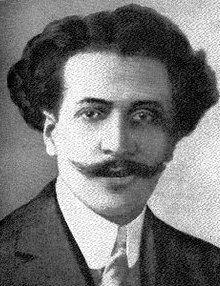Eugeni Bonaventura de Vigo i Sallés
| Miguel Almereyda | |
|---|---|
 |
|
| Born |
Eugène Bonaventure Jean-Baptiste Vigo 3 January 1883 Béziers, Hérault, France |
| Died | 14 August 1917 (aged 34) Fresnes Prison, Fresnes, Val-de-Marne, France |
| Nationality | French |
| Occupation | Photographer, journalist |
| Known for | Anti-militarism |
Eugène Bonaventure Jean-Baptiste Vigo (known as Miguel Almereyda; 5 January 1883 – 14 August 1917) was a French journalist and activist against militarism. He was first an anarchist and then a socialist. He founded and wrote in the newspaper La Guerre sociale and the satirical weekly Le Bonnet rouge. During World War I (1914–18) he engaged in dubious business dealings that brought him considerable wealth. He became engaged in a struggle with right-wing forces, and was eventually arrested on the grounds of being a German agent. He died in prison at the age of 34, almost certainly murdered. He was the father of the film director Jean Vigo.
Eugène Bonaventure Jean-Baptiste Vigo was born on 5 January 1883 in Béziers, Hérault. His father was engaged in trade, born in Saillagouse, and his mother Aimée Salles was a seamstress from Perpignan. The family originated in Err, Pyrénées-Orientales. His grandfather, from a family of minor nobility, was the magistrate and military chief of Andorra. His father died young. His mother moved back to Perpignan, where she married Gabriel Aubès, a photographer. Eugène Bonaventure remained with his mother's parents when his mother and stepfather moved to the Dordogne and then to Paris. He joined them there at the age of fifteen, and Aubès helped him gain an apprenticeship as a photographer. He struggled to make a living, but found friends in anarchist circles, including the slightly older Fernand Desprès, for which he became known to the police.
Eugène Vigo was arrested in May 1900, ostensibly as an accessory in the receipt of stolen goods, but in fact for his anarchist activity. He served two months in prison at la Petite Roquette. It was here that he changed his name to "Miguel Almereyda". "Almereyda" is an anagram of "y'a la merde!" (there's shit) After being released he found work with a photographer on the Boulevard Saint-Denis, and published his first article in Le Libertaire in which he described plans to attack the judge who had convicted him with a bomb. This fizzled out, but in the summer of 1901 the police found explosives in his room. Almereyda was sentenced to a year in prison. He was released after serving most of his sentence, and again found work with a photographer.
Almereyda again began writing for Le Libertaire, and by the start of 1903 was one of the most prolific of the journal's writers. In March 1903 he gave up photography to devote himself to journalism and political activism. Around this time he fell in love with Emily Cléro, a young militant, and they began to live together. The Ligue antimilitariste was founded in December 1902 by the anarchists Georges Yvetot, Henri Beylie, Paraf-Javal, Albert Libertad and Émile Janvion. This became the French section of the Association internationale antimilitariste (AIA), which was the subject of intense police surveillance. In 26–28 June 1904 the AIA held its founding congress in Amsterdam, with a 12-member delegation from France. Yvetot and Almereyda led the French section and sat on the AIA committee. The congress was dominated by anarchists, but also included syndicalists and communists. The question of whether refusal of military service should be AIA strategy was hotly debated.
...
Wikipedia
